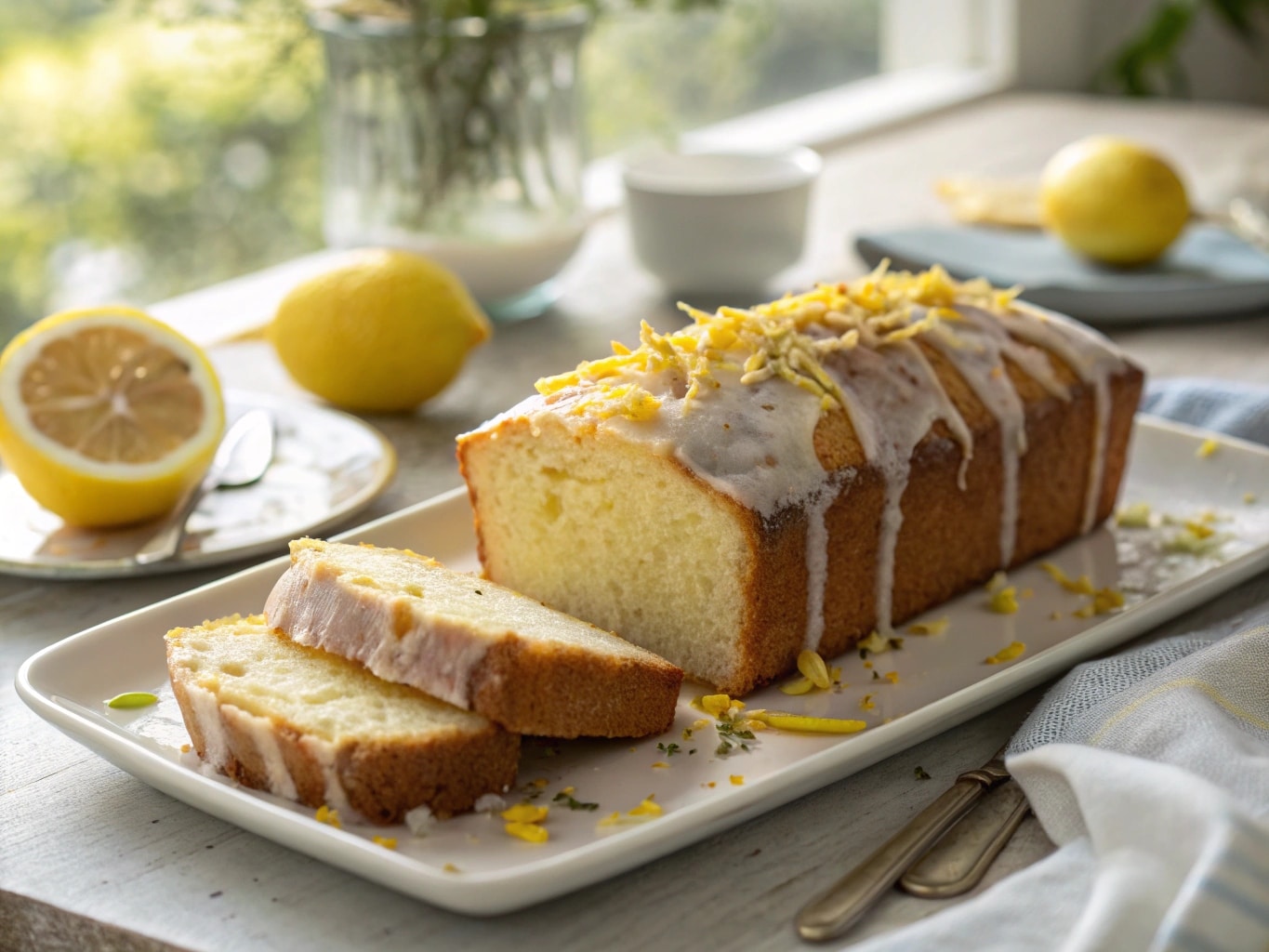If you’re a fan of classic desserts with a bright, zesty twist, this lemon pound cake recipe is about to become your favorite. Moist, rich, and bursting with citrus flavor, lemon pound cake is one of those timeless treats that work for brunches, tea time, or even holiday desserts. We’re diving deep into everything you need to know: from secrets to ultra-moist texture to crafting the perfect lemon glaze. Whether you’re new to baking or looking to upgrade your current recipe, this guide has you covered.
Looking for inspiration? Try this lemon cream cheese dump cake for another citrusy delight that’s easy to whip up.

Lemon Buttermilk Pound Cake
Equipment
Ingredients
- 1 cup unsalted butter, room temperature
- 1 ¾ cups granulated sugar
- 4 large eggs
- 2 cups all-purpose flour
- ½ tsp baking powder
- ¼ tsp salt
- ½ cup buttermilk
- ¼ cup fresh lemon juice
- 1 tbsp lemon zest
- 1 tsp vanilla extract
- 1 cup powdered sugar (for glaze)
- 2–3 tbsp fresh lemon juice (for glaze)
- ½ tsp lemon zest (optional, for glaze)
Instructions
- Preheat oven to 325°F (163°C). Grease a standard Bundt or loaf pan and dust with flour.
- Cream butter and sugar together in a large bowl until light and fluffy, about 3–4 minutes.
- Add eggs one at a time, beating well after each addition. Scrape down the bowl as needed.
- In a separate bowl, whisk flour, baking powder, and salt.
- In another bowl, combine buttermilk, lemon juice, lemon zest, and vanilla extract.
- Alternate adding dry and wet ingredients to the butter mixture, beginning and ending with dry. Mix until just combined.
- Pour into prepared pan. Bake for 55–65 minutes or until a toothpick comes out clean.
- Cool in the pan for 10 minutes, then invert onto a wire rack and cool completely.
- Make the glaze: whisk powdered sugar, lemon juice, and zest until smooth. Drizzle over cooled cake and let set.
Notes
Nutrition
Table of Contents
Why the Lemon Pound Cake Recipe Is a Timeless Classic
What Makes a Lemon Pound Cake Recipe So Special?
There’s something uniquely comforting about a lemon pound cake recipe that keeps bakers and dessert lovers coming back to it again and again. It combines the rich, buttery texture of a classic pound cake with the zesty brightness of lemon, creating a dessert that’s both indulgent and refreshing. The balance of dense cake and citrus tang is what gives a lemon pound cake recipe its signature charm.
Unlike airy cakes that rely on whipped egg whites, the structure of a lemon pound cake recipe is hearty and satisfying. The lemon flavor doesn’t just enhance the taste—it elevates it, adding complexity to every bite. Whether served plain, glazed, or with berries, it’s a dessert that stands tall on any table.
Looking for inspiration? Try this lemon cream cheese dump cake, which shares that signature citrus twist in a totally unique format.
Brief History and Origin of the Lemon Pound Cake Recipe
The roots of the lemon pound cake recipe trace back to the traditional pound cake, which originated in Europe in the 1700s. Originally made with a pound each of flour, sugar, butter, and eggs, the base recipe has been adapted over centuries to include flavorful ingredients like vanilla, cream cheese, and citrus—especially lemon.
In the Southern United States, the lemon pound cake recipe evolved into a regional favorite. Home bakers began incorporating lemon juice, lemon zest, and later, buttermilk, to produce a softer crumb and more vibrant taste. These variations gave rise to modern favorites like the lemon buttermilk pound cake, loved for its rich yet tangy flavor profile.
Want to explore more classic flavors? Discover great ideas like this strawberry pound cake, another Southern-inspired twist on the original.
Today, the lemon pound cake recipe remains a go-to for its simplicity, flexibility, and undeniable crowd-pleasing flavor. It’s equally at home in a Bundt pan, loaf tin, or layered into a trifle—no matter the form, its nostalgic appeal never fades.
Don’t miss our key lime cake recipe for another citrus-forward dessert that plays with tropical tang.
Key Ingredients for a Moist Pound Cake Recipe
Essential Baking Ingredients You Need
To master a perfect lemon pound cake recipe, it starts with high-quality, carefully measured ingredients. This isn’t a cake that hides flaws under layers of frosting. It shines through its texture and flavor, so every ingredient must work in harmony.
Here’s a breakdown of what you’ll need for a classic yet moist pound cake recipe:
| Ingredient | Purpose |
|---|---|
| Unsalted Butter | Provides richness and structure |
| Granulated Sugar | Adds sweetness and moisture |
| Large Eggs | Binds ingredients and builds texture |
| All-Purpose Flour | Gives the cake its dense body |
| Baking Powder | Lightly lifts the batter |
| Salt | Enhances overall flavor |
| Fresh Lemon Juice | Delivers bold, citrus flavor |
| Lemon Zest | Intensifies lemon aroma |
| Buttermilk | Tenderizes the crumb and adds depth |
| Vanilla Extract | Adds warm undertones |
If you’re aiming for a next-level lemon pound cake recipe, don’t underestimate the impact of fresh lemon zest and real lemon juice. These are what make the citrus pop and distinguish it from artificial-tasting versions.
Check out our angel food cake guide to understand how different ingredients affect cake texture and consistency.
Role of Buttermilk and Lemon Juice in the Recipe
Adding buttermilk is one of the best ways to turn a standard pound cake into a truly moist pound cake recipe. Buttermilk’s slight acidity reacts with the baking powder and baking soda, helping the cake rise gently and evenly. It also breaks down gluten slightly, making for a tender and soft crumb.
In the case of a lemon buttermilk pound cake, you get the added bonus of tanginess that enhances the lemon flavor beautifully. The combination of lemon juice and buttermilk ensures that the cake isn’t just moist—it’s full of vibrant citrus complexity.
What happens when you add lemon juice to cake batter? Great question—it not only boosts flavor, but it also contributes to the cake’s texture by reacting with baking soda or powder for a softer crumb. But be careful: too much lemon juice without balancing it with leaveners or buttermilk can make your cake too dense or even curdled.
Discover great ideas like our limoncello mascarpone cake, which uses a similar flavor layering technique.
If you’ve ever wondered what makes a cake tender but structured, this is it—the strategic use of acidic ingredients like buttermilk and lemon juice combined with fat-rich butter. That’s how you get a lemon pound cake recipe that’s moist without being soggy.
Don’t miss our vegan options at Nothing Bundt Cakes for an alternative look at how moistness can be achieved without dairy.
How to Make a Lemon Pound Cake Recipe from Scratch
Step-by-Step Preparation Instructions
If you’re wondering how to make a lemon pound cake recipe from scratch that’s fluffy, moist, and bursting with citrus flavor, this section is for you. We’ll guide you through the full process, from prepping your ingredients to baking the perfect pound cake.
Here’s a simple, fail-proof lemon pound cake recipe that yields consistent results every time:
Ingredients:
- 1 cup unsalted butter (room temperature)
- 1 ¾ cups granulated sugar
- 4 large eggs
- 2 cups all-purpose flour
- ½ tsp baking powder
- ¼ tsp salt
- ½ cup buttermilk
- ¼ cup fresh lemon juice
- 1 tbsp lemon zest
- 1 tsp vanilla extract
Instructions:
- Preheat oven to 325°F (163°C). Grease a standard Bundt pan or loaf pan and dust with flour.
- Cream butter and sugar together in a large bowl until light and fluffy—this can take 3–4 minutes using a hand mixer.
- Add eggs, one at a time, beating well after each addition. Scrape down the sides of the bowl as needed.
- In a separate bowl, whisk together the flour, baking powder, and salt.
- Mix the wet ingredients: combine the buttermilk, lemon juice, lemon zest, and vanilla extract.
- Alternate additions: Gradually add the dry and wet mixtures to the butter mixture, beginning and ending with dry ingredients. Mix just until combined—don’t overmix!
- Pour into pan and smooth the top. Bake for 55–65 minutes, or until a toothpick inserted into the center comes out clean.
- Cool in pan for 10 minutes before inverting onto a wire rack. Allow it to cool completely before glazing.
This classic lemon pound cake recipe delivers a fine crumb, rich flavor, and just the right citrus kick. The secret to its success lies in the balance of fat (butter), acid (lemon juice and buttermilk), and aeration (proper creaming and gentle mixing).
Don’t miss our moist and indulgent coffee cake recipe for more baked comfort food inspiration.

Common Mistakes to Avoid for Perfect Results
Even the best lemon pound cake recipe can fail if you fall into a few common traps. Here’s what to watch out for:
1. Cold Ingredients
Using cold butter, eggs, or buttermilk can cause your batter to curdle or not mix evenly. Always use room-temperature ingredients for smooth incorporation.
2. Overmixing the Batter
This is a cardinal sin when baking pound cakes. Overmixing develops too much gluten, making your cake tough instead of tender. Once your flour is added, mix until just combined.
3. Incorrect Oven Temperature
Many ovens run hot or cold. Always use an oven thermometer and bake low and slow at 325°F to prevent the outside from browning too fast while the inside remains undercooked.
4. Not Measuring Properly
Use a kitchen scale or spoon-and-level method for measuring flour. Too much flour leads to a dry cake, even with all that butter and lemon juice.
Check out our vegan red velvet cake with beetroot for another scratch-made success that depends on balance and technique.
By mastering these small yet important steps, your lemon pound cake recipe will turn out bakery-quality every single time—moist, flavorful, and irresistibly golden.
Perfecting the Lemon Buttermilk Pound Cake
What Makes Lemon Buttermilk Pound Cake Unique?
The lemon buttermilk pound cake is a luxurious twist on the classic lemon pound cake recipe. The addition of buttermilk is what transforms a standard crumb into something far more velvety, tender, and flavorful.
Buttermilk’s natural acidity enhances the tang of the lemon juice, making each slice more vibrant. It also reacts with the leavening agents (baking powder or baking soda), creating a finer crumb and gentle lift. This gives your lemon buttermilk pound cake an almost melt-in-your-mouth consistency.
Unlike regular milk, buttermilk keeps the cake moist for days—perfect if you’re baking ahead of time. Combined with lemon zest and fresh lemon juice, it amplifies citrus notes and provides a fuller flavor profile.
Check out our limoncello mascarpone cake to see another rich citrus dessert done right.
Why Buttermilk Adds Richness and Tender Crumb
Here’s what buttermilk does in a lemon pound cake recipe:
- Softens gluten strands, preventing a chewy or tough texture
- Adds a tangy flavor that complements lemon zest beautifully
- Boosts rise and fluffiness through acid-base chemical reactions
- Extends shelf life by retaining internal moisture longer
If you’re aiming for a next-level moist pound cake recipe, don’t skip the buttermilk. It’s a small addition with huge payoff in texture, flavor, and freshness.

The Ultimate Lemon Glaze for Bundt Cake or Pound Cake
Best Pound Cake Glaze Recipe Techniques
No lemon pound cake recipe is truly complete without the right glaze. A simple glaze can turn a good cake into a stunning dessert centerpiece. Whether you’re glazing a loaf or a bundt, this pound cake glaze recipe delivers the perfect final touch.
Basic Lemon Glaze for Pound Cake:
- 1 cup powdered sugar
- 2–3 tablespoons fresh lemon juice
- ½ teaspoon lemon zest (optional)
Instructions:
Whisk all ingredients in a small bowl until smooth and pourable. Drizzle over cooled cake and let set for 20–30 minutes.
The key here is achieving the right consistency—not too thin, or it’ll soak into the cake. Not too thick, or it won’t spread easily. You want a luscious glaze that locks in moisture and adds a citrus punch on top.
Don’t miss our vegan options at Nothing Bundt Cakes for more bundt-specific cake inspiration.
How to Customize a Lemon Glaze for Bundt Cake Appeal
For a visually stunning lemon glaze for bundt cake, presentation matters just as much as flavor. Here’s how to elevate your glaze:
| Glaze Add-In | Flavor Boost |
|---|---|
| Vanilla extract | Adds warmth and depth |
| Cream or butter | Makes the glaze richer and creamier |
| Chopped herbs (e.g., thyme) | Adds elegance and aroma |
| Citrus liqueur (e.g., limoncello) | Intensifies citrus kick |
Pro Tip: Chill your bundt cake before glazing for a cleaner drip effect.
Flavor Enhancements You Can Add
What Can You Add to Lemon Pound Cake Recipe?
Your lemon pound cake recipe doesn’t have to be plain. There are so many exciting ways to elevate the flavor without overwhelming the signature citrus profile.
Here are some top additions you can experiment with:
| Add-In | Result |
|---|---|
| Poppy seeds | Adds subtle crunch and visual flair |
| Blueberries | Infuses bursts of sweetness and color |
| Coconut flakes | Creates a tropical flavor layer |
| Cream cheese swirl | Adds rich, tangy contrast |
| Almond extract | Gives a nutty undertone |
Looking for inspiration? Try our fruity strawberry pound cake that shows how fruit infusions can bring new life to old favorites.
Citrus Zest, Berries, and Creative Mix-ins
Want even more depth? Try these:
- Citrus zest (lime, orange) to layer complex citrus notes
- Candied ginger for a warm, spicy surprise
- Lemon curd swirl to intensify lemon flavor
- Chopped white chocolate for a creamy sweetness
Each of these variations keeps the heart of the lemon pound cake recipe intact, while adding character, richness, and that wow factor your guests won’t forget.
Don’t miss our key lime cake recipe for another way to use citrus creatively in desserts.
for more cake recipes follow us in Pinterest
Frequently Asked Questions (FAQ)
What is the secret to a good pound cake?
The secret to a good lemon pound cake recipe lies in balance—perfect ratios of fat, flour, and sugar, combined with quality ingredients like fresh lemon juice and zest. But perhaps more importantly, the mixing technique is key. Creaming the butter and sugar thoroughly until light and fluffy introduces air, which helps the cake rise and gives it that tender crumb. Also, always use room-temperature ingredients for consistent texture.
What happens when you add lemon juice to cake batter?
When you add lemon juice to cake batter, it not only enhances the flavor but also plays a chemical role. The acidity in the lemon juice reacts with baking soda or baking powder, helping the cake rise and contributing to a lighter texture. In a lemon pound cake recipe, this reaction helps soften the crumb and brighten the overall taste.
What is the secret to super moist cake?
The key to a super moist lemon pound cake recipe is a combination of fat and acid. Butter brings richness, buttermilk or sour cream adds tang and moisture, and the proper amount of sugar helps retain hydration during baking. Avoid overmixing, and don’t overbake—both will dry out your cake. Covering the cake tightly after cooling also helps keep it moist for days.
Can I use lemon juice instead of lemon extract in pound cake?
Yes, you can substitute lemon juice for lemon extract in a lemon pound cake recipe, but keep in mind they’re not a 1:1 replacement. Lemon extract is concentrated, so you’ll need more lemon juice to achieve the same flavor intensity. Additionally, lemon juice adds liquid to your batter, which can affect texture. To compensate, consider adjusting the other wet ingredients slightly.
How to make a lemon pound cake recipe?
To make a classic lemon pound cake recipe, start by creaming butter and sugar until fluffy, then beat in eggs one at a time. Alternate adding flour with a mixture of lemon juice, zest, and buttermilk. Pour into a greased pan and bake at 325°F until golden and set. Finish with a zesty pound cake glaze recipe using lemon juice and powdered sugar for the perfect citrus topping.
What can you add to lemon pound cake recipe?
You can enhance a lemon pound cake recipe with a variety of flavorful mix-ins. Popular additions include blueberries, poppy seeds, coconut flakes, and even a swirl of lemon curd or cream cheese. These elements complement the lemon flavor and add texture, richness, or visual appeal. For more advanced flavor layering, try mixing in orange or lime zest alongside lemon for a deeper citrus profile.

